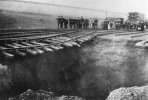Ashley Hill
Established Member
Over the years many railway vehicles were buried instead of scrapped due to their asbestos content. Famously 27043 in Patersons Tip in Glasgow and two Blue Pullman coaches in Cohens Morriston. There were other vehicles too! Given these burials took place some decades ago has any redevelopment ever taken place (housing/industrial) on these sites that has unearthed such items? Or have any been dug up for a greener disposal?
Last edited:


